Valeant Group Financial Performance
VerifiedAdded on 2020/02/14
|33
|10115
|49
Thesis and Dissertation
AI Summary
This dissertation analyzes the business and financial performance of Valeant Group, comparing it to its competitor, GlaxoSmithKline (GSK). It utilizes ratio analysis to evaluate profitability, liquidity, solvency, and managerial efficiency. The study employs a case study research design, using secondary data from annual financial reports and credible online sources. Findings indicate that GSK outperformed Valeant in profitability and efficiency, while Valeant showed a stronger liquidity position. The dissertation concludes with recommendations for Valeant to improve its R&D investment, control indirect expenses, enhance its current ratio, reduce debt dependency, and improve employee training to enhance overall performance and competitiveness.
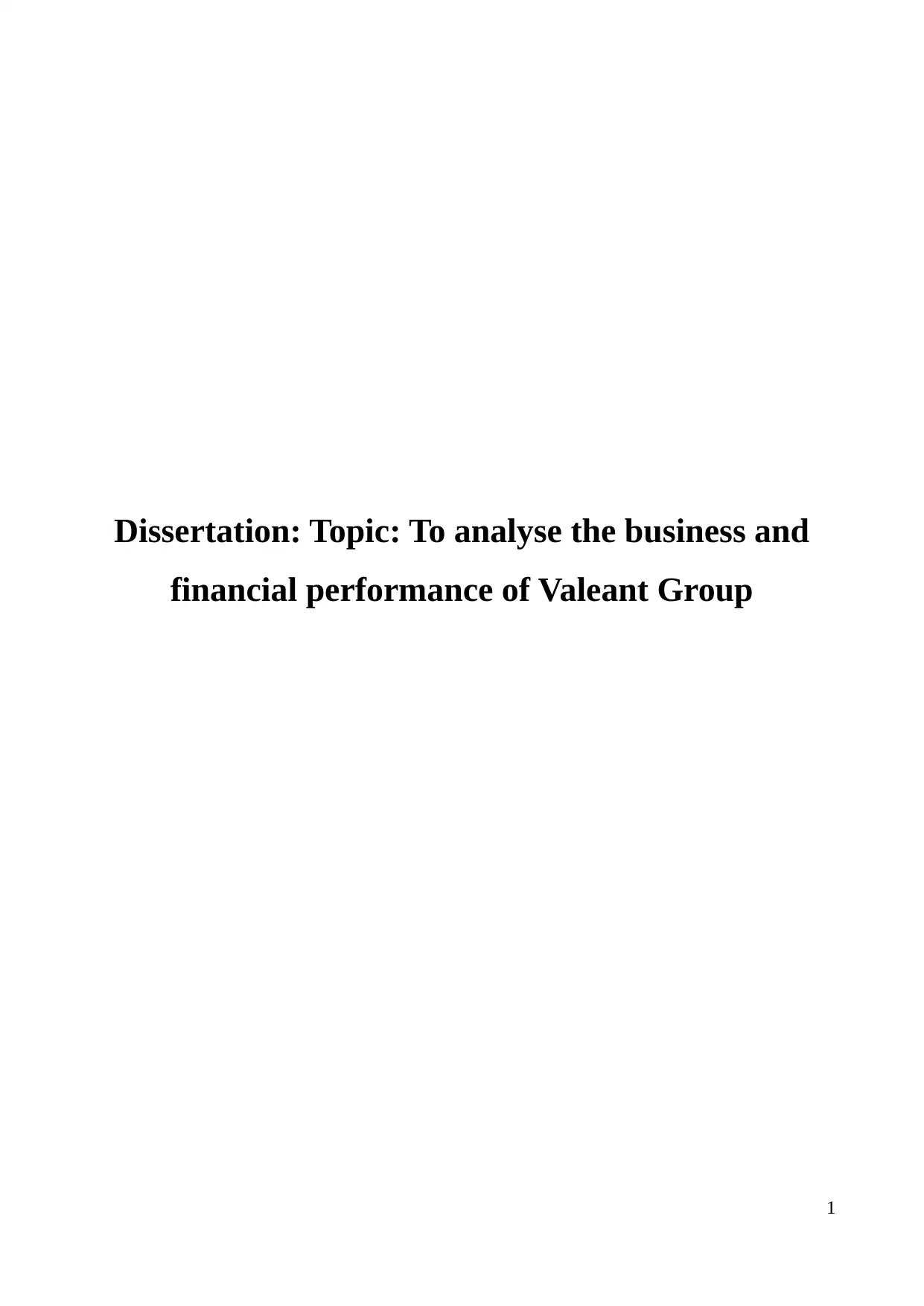
Dissertation: Topic: To analyse the business and
financial performance of Valeant Group
1
financial performance of Valeant Group
1
Paraphrase This Document
Need a fresh take? Get an instant paraphrase of this document with our AI Paraphraser
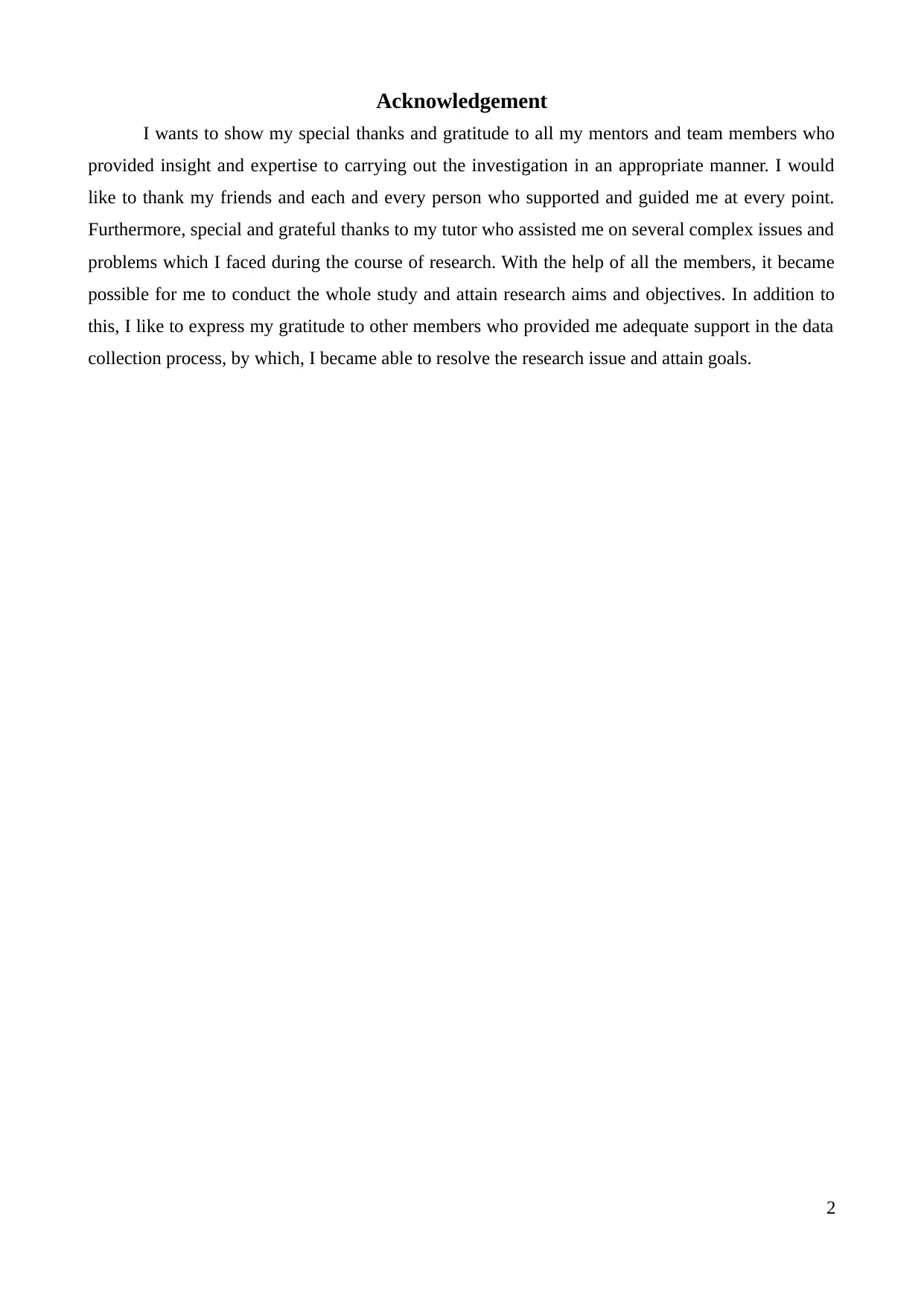
Acknowledgement
I wants to show my special thanks and gratitude to all my mentors and team members who
provided insight and expertise to carrying out the investigation in an appropriate manner. I would
like to thank my friends and each and every person who supported and guided me at every point.
Furthermore, special and grateful thanks to my tutor who assisted me on several complex issues and
problems which I faced during the course of research. With the help of all the members, it became
possible for me to conduct the whole study and attain research aims and objectives. In addition to
this, I like to express my gratitude to other members who provided me adequate support in the data
collection process, by which, I became able to resolve the research issue and attain goals.
2
I wants to show my special thanks and gratitude to all my mentors and team members who
provided insight and expertise to carrying out the investigation in an appropriate manner. I would
like to thank my friends and each and every person who supported and guided me at every point.
Furthermore, special and grateful thanks to my tutor who assisted me on several complex issues and
problems which I faced during the course of research. With the help of all the members, it became
possible for me to conduct the whole study and attain research aims and objectives. In addition to
this, I like to express my gratitude to other members who provided me adequate support in the data
collection process, by which, I became able to resolve the research issue and attain goals.
2
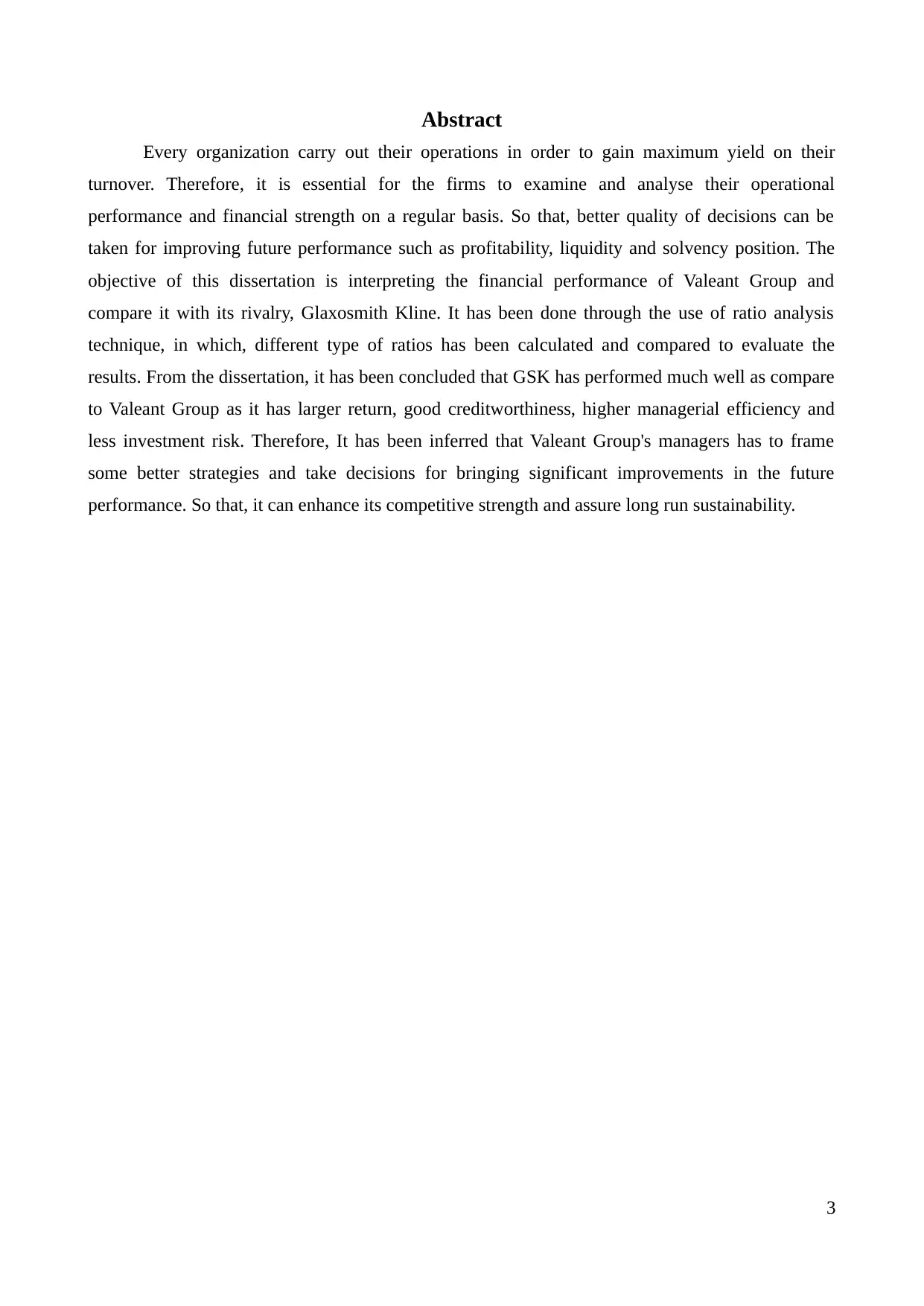
Abstract
Every organization carry out their operations in order to gain maximum yield on their
turnover. Therefore, it is essential for the firms to examine and analyse their operational
performance and financial strength on a regular basis. So that, better quality of decisions can be
taken for improving future performance such as profitability, liquidity and solvency position. The
objective of this dissertation is interpreting the financial performance of Valeant Group and
compare it with its rivalry, Glaxosmith Kline. It has been done through the use of ratio analysis
technique, in which, different type of ratios has been calculated and compared to evaluate the
results. From the dissertation, it has been concluded that GSK has performed much well as compare
to Valeant Group as it has larger return, good creditworthiness, higher managerial efficiency and
less investment risk. Therefore, It has been inferred that Valeant Group's managers has to frame
some better strategies and take decisions for bringing significant improvements in the future
performance. So that, it can enhance its competitive strength and assure long run sustainability.
3
Every organization carry out their operations in order to gain maximum yield on their
turnover. Therefore, it is essential for the firms to examine and analyse their operational
performance and financial strength on a regular basis. So that, better quality of decisions can be
taken for improving future performance such as profitability, liquidity and solvency position. The
objective of this dissertation is interpreting the financial performance of Valeant Group and
compare it with its rivalry, Glaxosmith Kline. It has been done through the use of ratio analysis
technique, in which, different type of ratios has been calculated and compared to evaluate the
results. From the dissertation, it has been concluded that GSK has performed much well as compare
to Valeant Group as it has larger return, good creditworthiness, higher managerial efficiency and
less investment risk. Therefore, It has been inferred that Valeant Group's managers has to frame
some better strategies and take decisions for bringing significant improvements in the future
performance. So that, it can enhance its competitive strength and assure long run sustainability.
3
⊘ This is a preview!⊘
Do you want full access?
Subscribe today to unlock all pages.

Trusted by 1+ million students worldwide
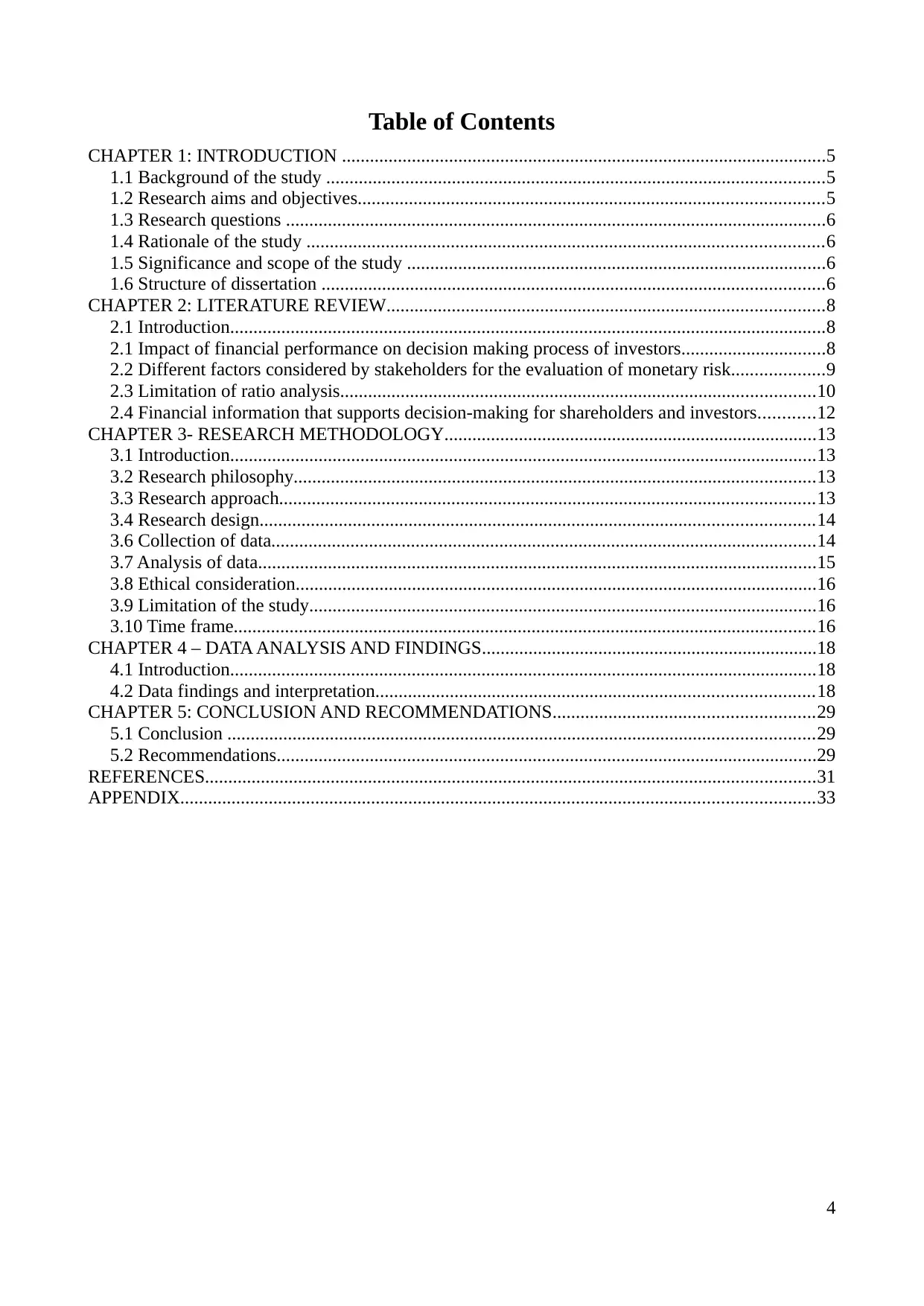
Table of Contents
CHAPTER 1: INTRODUCTION ........................................................................................................5
1.1 Background of the study ...........................................................................................................5
1.2 Research aims and objectives....................................................................................................5
1.3 Research questions ....................................................................................................................6
1.4 Rationale of the study ...............................................................................................................6
1.5 Significance and scope of the study ..........................................................................................6
1.6 Structure of dissertation ............................................................................................................6
CHAPTER 2: LITERATURE REVIEW..............................................................................................8
2.1 Introduction................................................................................................................................8
2.1 Impact of financial performance on decision making process of investors...............................8
2.2 Different factors considered by stakeholders for the evaluation of monetary risk....................9
2.3 Limitation of ratio analysis......................................................................................................10
2.4 Financial information that supports decision-making for shareholders and investors............12
CHAPTER 3- RESEARCH METHODOLOGY................................................................................13
3.1 Introduction..............................................................................................................................13
3.2 Research philosophy................................................................................................................13
3.3 Research approach...................................................................................................................13
3.4 Research design.......................................................................................................................14
3.6 Collection of data.....................................................................................................................14
3.7 Analysis of data........................................................................................................................15
3.8 Ethical consideration................................................................................................................16
3.9 Limitation of the study.............................................................................................................16
3.10 Time frame.............................................................................................................................16
CHAPTER 4 – DATA ANALYSIS AND FINDINGS........................................................................18
4.1 Introduction..............................................................................................................................18
4.2 Data findings and interpretation..............................................................................................18
CHAPTER 5: CONCLUSION AND RECOMMENDATIONS........................................................29
5.1 Conclusion ..............................................................................................................................29
5.2 Recommendations....................................................................................................................29
REFERENCES...................................................................................................................................31
APPENDIX........................................................................................................................................33
4
CHAPTER 1: INTRODUCTION ........................................................................................................5
1.1 Background of the study ...........................................................................................................5
1.2 Research aims and objectives....................................................................................................5
1.3 Research questions ....................................................................................................................6
1.4 Rationale of the study ...............................................................................................................6
1.5 Significance and scope of the study ..........................................................................................6
1.6 Structure of dissertation ............................................................................................................6
CHAPTER 2: LITERATURE REVIEW..............................................................................................8
2.1 Introduction................................................................................................................................8
2.1 Impact of financial performance on decision making process of investors...............................8
2.2 Different factors considered by stakeholders for the evaluation of monetary risk....................9
2.3 Limitation of ratio analysis......................................................................................................10
2.4 Financial information that supports decision-making for shareholders and investors............12
CHAPTER 3- RESEARCH METHODOLOGY................................................................................13
3.1 Introduction..............................................................................................................................13
3.2 Research philosophy................................................................................................................13
3.3 Research approach...................................................................................................................13
3.4 Research design.......................................................................................................................14
3.6 Collection of data.....................................................................................................................14
3.7 Analysis of data........................................................................................................................15
3.8 Ethical consideration................................................................................................................16
3.9 Limitation of the study.............................................................................................................16
3.10 Time frame.............................................................................................................................16
CHAPTER 4 – DATA ANALYSIS AND FINDINGS........................................................................18
4.1 Introduction..............................................................................................................................18
4.2 Data findings and interpretation..............................................................................................18
CHAPTER 5: CONCLUSION AND RECOMMENDATIONS........................................................29
5.1 Conclusion ..............................................................................................................................29
5.2 Recommendations....................................................................................................................29
REFERENCES...................................................................................................................................31
APPENDIX........................................................................................................................................33
4
Paraphrase This Document
Need a fresh take? Get an instant paraphrase of this document with our AI Paraphraser
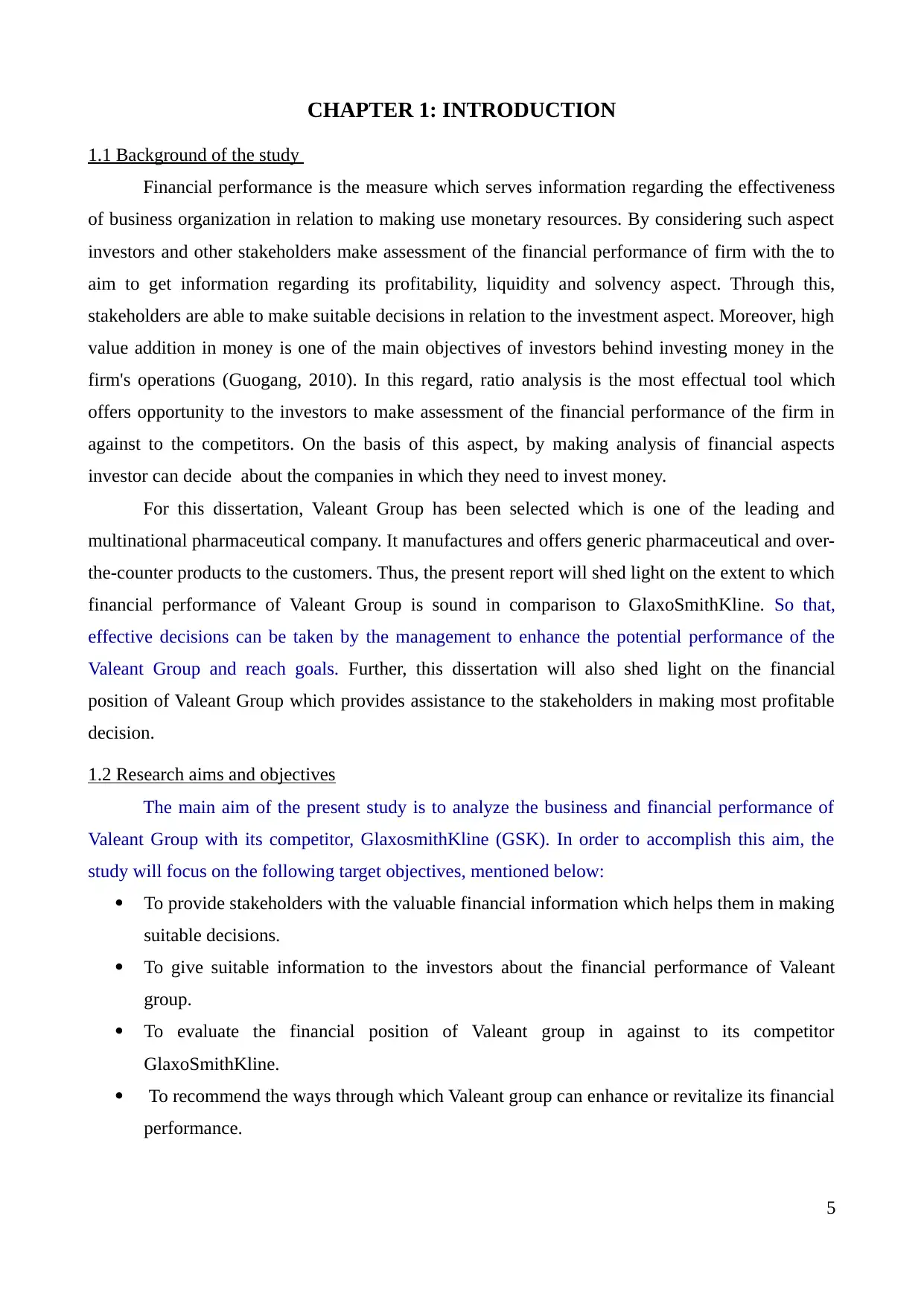
CHAPTER 1: INTRODUCTION
1.1 Background of the study
Financial performance is the measure which serves information regarding the effectiveness
of business organization in relation to making use monetary resources. By considering such aspect
investors and other stakeholders make assessment of the financial performance of firm with the to
aim to get information regarding its profitability, liquidity and solvency aspect. Through this,
stakeholders are able to make suitable decisions in relation to the investment aspect. Moreover, high
value addition in money is one of the main objectives of investors behind investing money in the
firm's operations (Guogang, 2010). In this regard, ratio analysis is the most effectual tool which
offers opportunity to the investors to make assessment of the financial performance of the firm in
against to the competitors. On the basis of this aspect, by making analysis of financial aspects
investor can decide about the companies in which they need to invest money.
For this dissertation, Valeant Group has been selected which is one of the leading and
multinational pharmaceutical company. It manufactures and offers generic pharmaceutical and over-
the-counter products to the customers. Thus, the present report will shed light on the extent to which
financial performance of Valeant Group is sound in comparison to GlaxoSmithKline. So that,
effective decisions can be taken by the management to enhance the potential performance of the
Valeant Group and reach goals. Further, this dissertation will also shed light on the financial
position of Valeant Group which provides assistance to the stakeholders in making most profitable
decision.
1.2 Research aims and objectives
The main aim of the present study is to analyze the business and financial performance of
Valeant Group with its competitor, GlaxosmithKline (GSK). In order to accomplish this aim, the
study will focus on the following target objectives, mentioned below:
To provide stakeholders with the valuable financial information which helps them in making
suitable decisions.
To give suitable information to the investors about the financial performance of Valeant
group.
To evaluate the financial position of Valeant group in against to its competitor
GlaxoSmithKline.
To recommend the ways through which Valeant group can enhance or revitalize its financial
performance.
5
1.1 Background of the study
Financial performance is the measure which serves information regarding the effectiveness
of business organization in relation to making use monetary resources. By considering such aspect
investors and other stakeholders make assessment of the financial performance of firm with the to
aim to get information regarding its profitability, liquidity and solvency aspect. Through this,
stakeholders are able to make suitable decisions in relation to the investment aspect. Moreover, high
value addition in money is one of the main objectives of investors behind investing money in the
firm's operations (Guogang, 2010). In this regard, ratio analysis is the most effectual tool which
offers opportunity to the investors to make assessment of the financial performance of the firm in
against to the competitors. On the basis of this aspect, by making analysis of financial aspects
investor can decide about the companies in which they need to invest money.
For this dissertation, Valeant Group has been selected which is one of the leading and
multinational pharmaceutical company. It manufactures and offers generic pharmaceutical and over-
the-counter products to the customers. Thus, the present report will shed light on the extent to which
financial performance of Valeant Group is sound in comparison to GlaxoSmithKline. So that,
effective decisions can be taken by the management to enhance the potential performance of the
Valeant Group and reach goals. Further, this dissertation will also shed light on the financial
position of Valeant Group which provides assistance to the stakeholders in making most profitable
decision.
1.2 Research aims and objectives
The main aim of the present study is to analyze the business and financial performance of
Valeant Group with its competitor, GlaxosmithKline (GSK). In order to accomplish this aim, the
study will focus on the following target objectives, mentioned below:
To provide stakeholders with the valuable financial information which helps them in making
suitable decisions.
To give suitable information to the investors about the financial performance of Valeant
group.
To evaluate the financial position of Valeant group in against to its competitor
GlaxoSmithKline.
To recommend the ways through which Valeant group can enhance or revitalize its financial
performance.
5
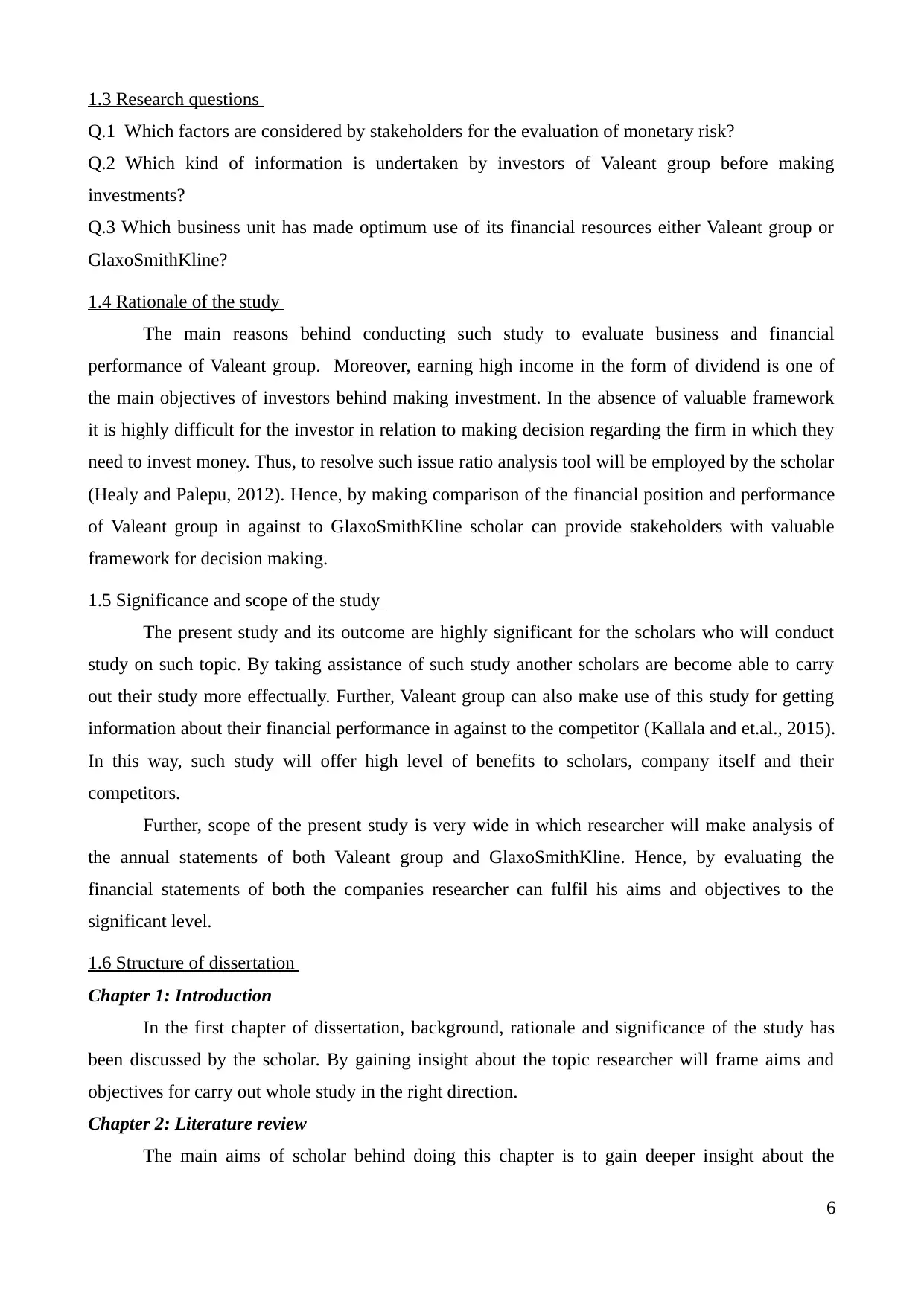
1.3 Research questions
Q.1 Which factors are considered by stakeholders for the evaluation of monetary risk?
Q.2 Which kind of information is undertaken by investors of Valeant group before making
investments?
Q.3 Which business unit has made optimum use of its financial resources either Valeant group or
GlaxoSmithKline?
1.4 Rationale of the study
The main reasons behind conducting such study to evaluate business and financial
performance of Valeant group. Moreover, earning high income in the form of dividend is one of
the main objectives of investors behind making investment. In the absence of valuable framework
it is highly difficult for the investor in relation to making decision regarding the firm in which they
need to invest money. Thus, to resolve such issue ratio analysis tool will be employed by the scholar
(Healy and Palepu, 2012). Hence, by making comparison of the financial position and performance
of Valeant group in against to GlaxoSmithKline scholar can provide stakeholders with valuable
framework for decision making.
1.5 Significance and scope of the study
The present study and its outcome are highly significant for the scholars who will conduct
study on such topic. By taking assistance of such study another scholars are become able to carry
out their study more effectually. Further, Valeant group can also make use of this study for getting
information about their financial performance in against to the competitor (Kallala and et.al., 2015).
In this way, such study will offer high level of benefits to scholars, company itself and their
competitors.
Further, scope of the present study is very wide in which researcher will make analysis of
the annual statements of both Valeant group and GlaxoSmithKline. Hence, by evaluating the
financial statements of both the companies researcher can fulfil his aims and objectives to the
significant level.
1.6 Structure of dissertation
Chapter 1: Introduction
In the first chapter of dissertation, background, rationale and significance of the study has
been discussed by the scholar. By gaining insight about the topic researcher will frame aims and
objectives for carry out whole study in the right direction.
Chapter 2: Literature review
The main aims of scholar behind doing this chapter is to gain deeper insight about the
6
Q.1 Which factors are considered by stakeholders for the evaluation of monetary risk?
Q.2 Which kind of information is undertaken by investors of Valeant group before making
investments?
Q.3 Which business unit has made optimum use of its financial resources either Valeant group or
GlaxoSmithKline?
1.4 Rationale of the study
The main reasons behind conducting such study to evaluate business and financial
performance of Valeant group. Moreover, earning high income in the form of dividend is one of
the main objectives of investors behind making investment. In the absence of valuable framework
it is highly difficult for the investor in relation to making decision regarding the firm in which they
need to invest money. Thus, to resolve such issue ratio analysis tool will be employed by the scholar
(Healy and Palepu, 2012). Hence, by making comparison of the financial position and performance
of Valeant group in against to GlaxoSmithKline scholar can provide stakeholders with valuable
framework for decision making.
1.5 Significance and scope of the study
The present study and its outcome are highly significant for the scholars who will conduct
study on such topic. By taking assistance of such study another scholars are become able to carry
out their study more effectually. Further, Valeant group can also make use of this study for getting
information about their financial performance in against to the competitor (Kallala and et.al., 2015).
In this way, such study will offer high level of benefits to scholars, company itself and their
competitors.
Further, scope of the present study is very wide in which researcher will make analysis of
the annual statements of both Valeant group and GlaxoSmithKline. Hence, by evaluating the
financial statements of both the companies researcher can fulfil his aims and objectives to the
significant level.
1.6 Structure of dissertation
Chapter 1: Introduction
In the first chapter of dissertation, background, rationale and significance of the study has
been discussed by the scholar. By gaining insight about the topic researcher will frame aims and
objectives for carry out whole study in the right direction.
Chapter 2: Literature review
The main aims of scholar behind doing this chapter is to gain deeper insight about the
6
⊘ This is a preview!⊘
Do you want full access?
Subscribe today to unlock all pages.

Trusted by 1+ million students worldwide
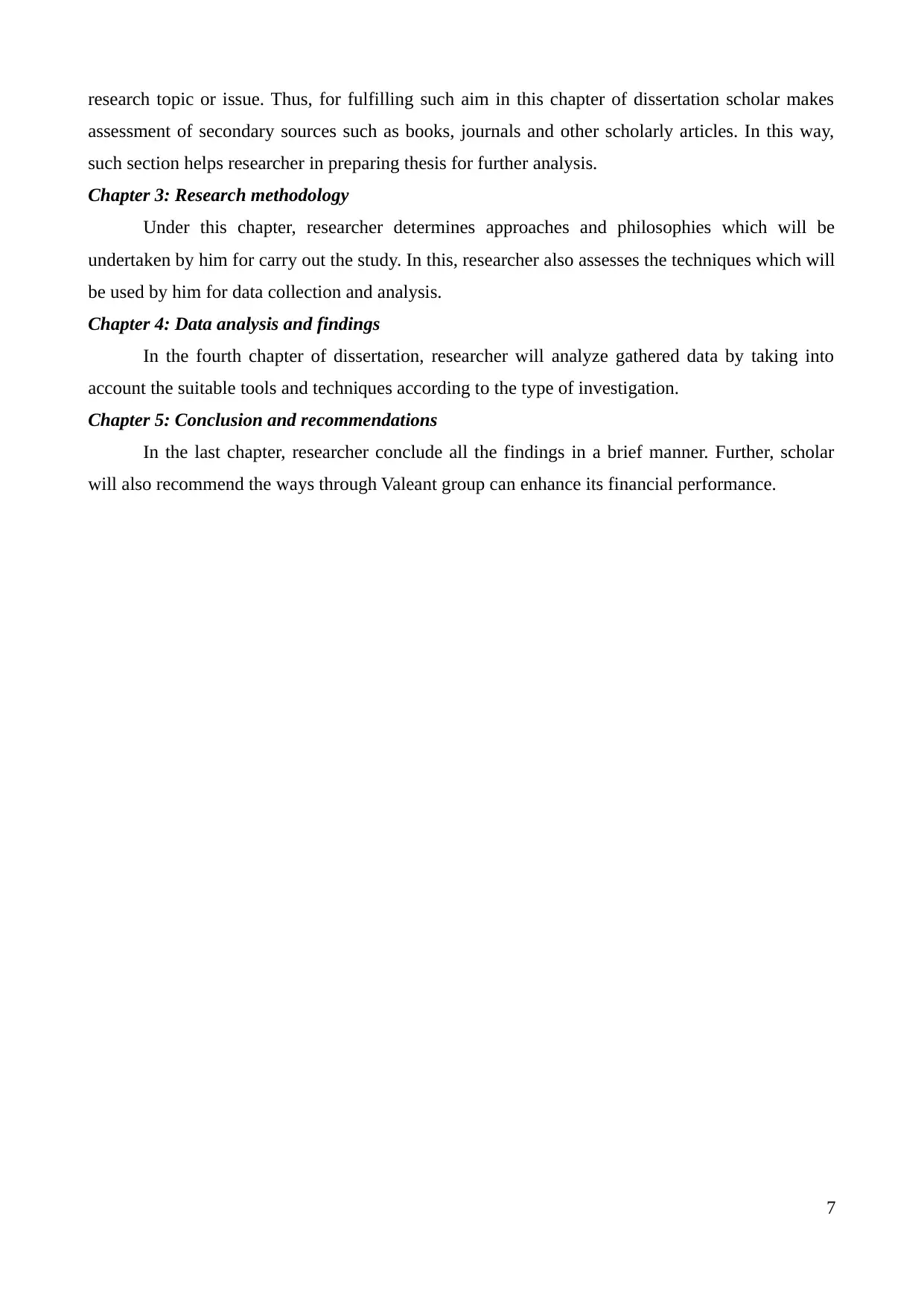
research topic or issue. Thus, for fulfilling such aim in this chapter of dissertation scholar makes
assessment of secondary sources such as books, journals and other scholarly articles. In this way,
such section helps researcher in preparing thesis for further analysis.
Chapter 3: Research methodology
Under this chapter, researcher determines approaches and philosophies which will be
undertaken by him for carry out the study. In this, researcher also assesses the techniques which will
be used by him for data collection and analysis.
Chapter 4: Data analysis and findings
In the fourth chapter of dissertation, researcher will analyze gathered data by taking into
account the suitable tools and techniques according to the type of investigation.
Chapter 5: Conclusion and recommendations
In the last chapter, researcher conclude all the findings in a brief manner. Further, scholar
will also recommend the ways through Valeant group can enhance its financial performance.
7
assessment of secondary sources such as books, journals and other scholarly articles. In this way,
such section helps researcher in preparing thesis for further analysis.
Chapter 3: Research methodology
Under this chapter, researcher determines approaches and philosophies which will be
undertaken by him for carry out the study. In this, researcher also assesses the techniques which will
be used by him for data collection and analysis.
Chapter 4: Data analysis and findings
In the fourth chapter of dissertation, researcher will analyze gathered data by taking into
account the suitable tools and techniques according to the type of investigation.
Chapter 5: Conclusion and recommendations
In the last chapter, researcher conclude all the findings in a brief manner. Further, scholar
will also recommend the ways through Valeant group can enhance its financial performance.
7
Paraphrase This Document
Need a fresh take? Get an instant paraphrase of this document with our AI Paraphraser
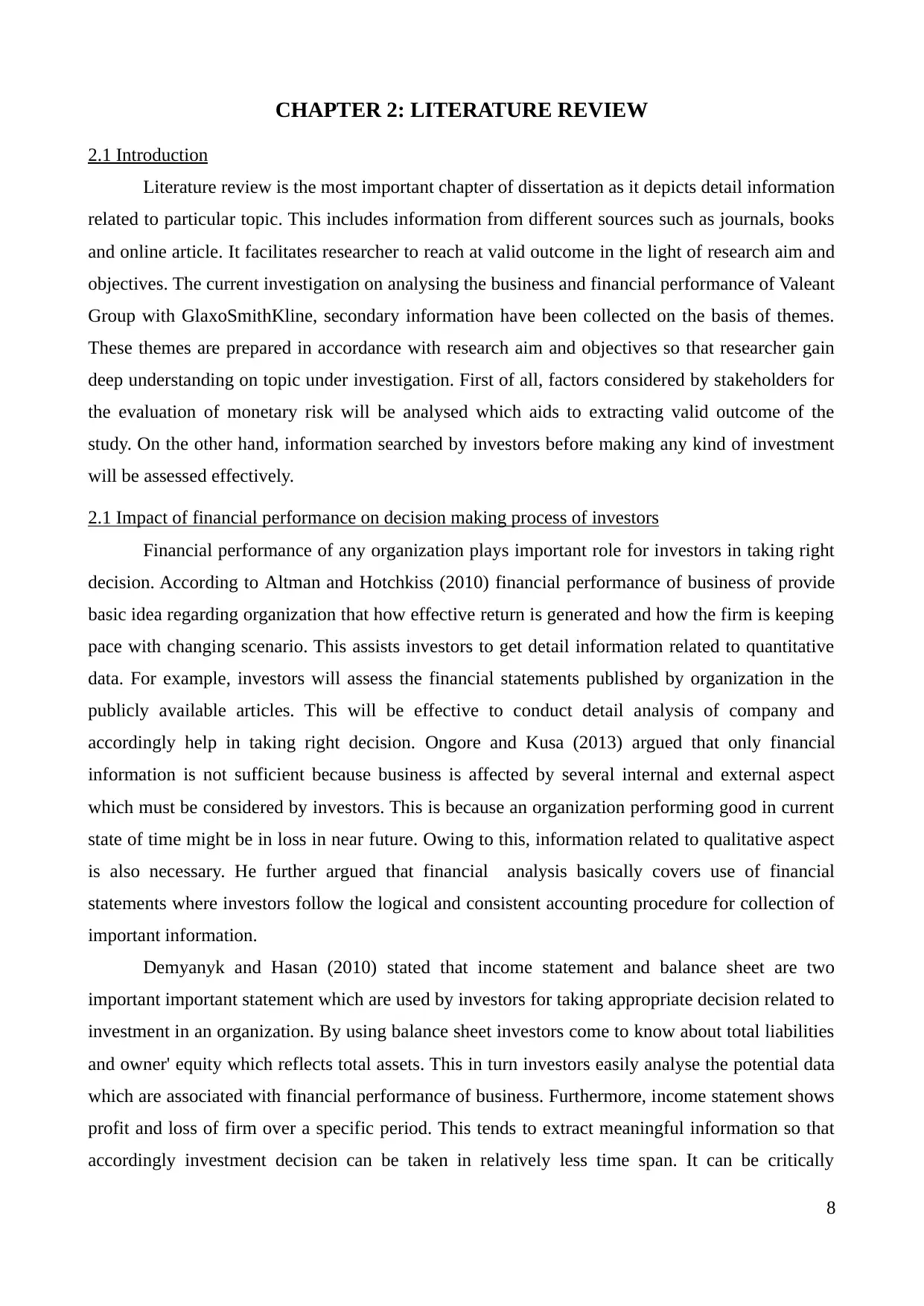
CHAPTER 2: LITERATURE REVIEW
2.1 Introduction
Literature review is the most important chapter of dissertation as it depicts detail information
related to particular topic. This includes information from different sources such as journals, books
and online article. It facilitates researcher to reach at valid outcome in the light of research aim and
objectives. The current investigation on analysing the business and financial performance of Valeant
Group with GlaxoSmithKline, secondary information have been collected on the basis of themes.
These themes are prepared in accordance with research aim and objectives so that researcher gain
deep understanding on topic under investigation. First of all, factors considered by stakeholders for
the evaluation of monetary risk will be analysed which aids to extracting valid outcome of the
study. On the other hand, information searched by investors before making any kind of investment
will be assessed effectively.
2.1 Impact of financial performance on decision making process of investors
Financial performance of any organization plays important role for investors in taking right
decision. According to Altman and Hotchkiss (2010) financial performance of business of provide
basic idea regarding organization that how effective return is generated and how the firm is keeping
pace with changing scenario. This assists investors to get detail information related to quantitative
data. For example, investors will assess the financial statements published by organization in the
publicly available articles. This will be effective to conduct detail analysis of company and
accordingly help in taking right decision. Ongore and Kusa (2013) argued that only financial
information is not sufficient because business is affected by several internal and external aspect
which must be considered by investors. This is because an organization performing good in current
state of time might be in loss in near future. Owing to this, information related to qualitative aspect
is also necessary. He further argued that financial analysis basically covers use of financial
statements where investors follow the logical and consistent accounting procedure for collection of
important information.
Demyanyk and Hasan (2010) stated that income statement and balance sheet are two
important important statement which are used by investors for taking appropriate decision related to
investment in an organization. By using balance sheet investors come to know about total liabilities
and owner' equity which reflects total assets. This in turn investors easily analyse the potential data
which are associated with financial performance of business. Furthermore, income statement shows
profit and loss of firm over a specific period. This tends to extract meaningful information so that
accordingly investment decision can be taken in relatively less time span. It can be critically
8
2.1 Introduction
Literature review is the most important chapter of dissertation as it depicts detail information
related to particular topic. This includes information from different sources such as journals, books
and online article. It facilitates researcher to reach at valid outcome in the light of research aim and
objectives. The current investigation on analysing the business and financial performance of Valeant
Group with GlaxoSmithKline, secondary information have been collected on the basis of themes.
These themes are prepared in accordance with research aim and objectives so that researcher gain
deep understanding on topic under investigation. First of all, factors considered by stakeholders for
the evaluation of monetary risk will be analysed which aids to extracting valid outcome of the
study. On the other hand, information searched by investors before making any kind of investment
will be assessed effectively.
2.1 Impact of financial performance on decision making process of investors
Financial performance of any organization plays important role for investors in taking right
decision. According to Altman and Hotchkiss (2010) financial performance of business of provide
basic idea regarding organization that how effective return is generated and how the firm is keeping
pace with changing scenario. This assists investors to get detail information related to quantitative
data. For example, investors will assess the financial statements published by organization in the
publicly available articles. This will be effective to conduct detail analysis of company and
accordingly help in taking right decision. Ongore and Kusa (2013) argued that only financial
information is not sufficient because business is affected by several internal and external aspect
which must be considered by investors. This is because an organization performing good in current
state of time might be in loss in near future. Owing to this, information related to qualitative aspect
is also necessary. He further argued that financial analysis basically covers use of financial
statements where investors follow the logical and consistent accounting procedure for collection of
important information.
Demyanyk and Hasan (2010) stated that income statement and balance sheet are two
important important statement which are used by investors for taking appropriate decision related to
investment in an organization. By using balance sheet investors come to know about total liabilities
and owner' equity which reflects total assets. This in turn investors easily analyse the potential data
which are associated with financial performance of business. Furthermore, income statement shows
profit and loss of firm over a specific period. This tends to extract meaningful information so that
accordingly investment decision can be taken in relatively less time span. It can be critically
8
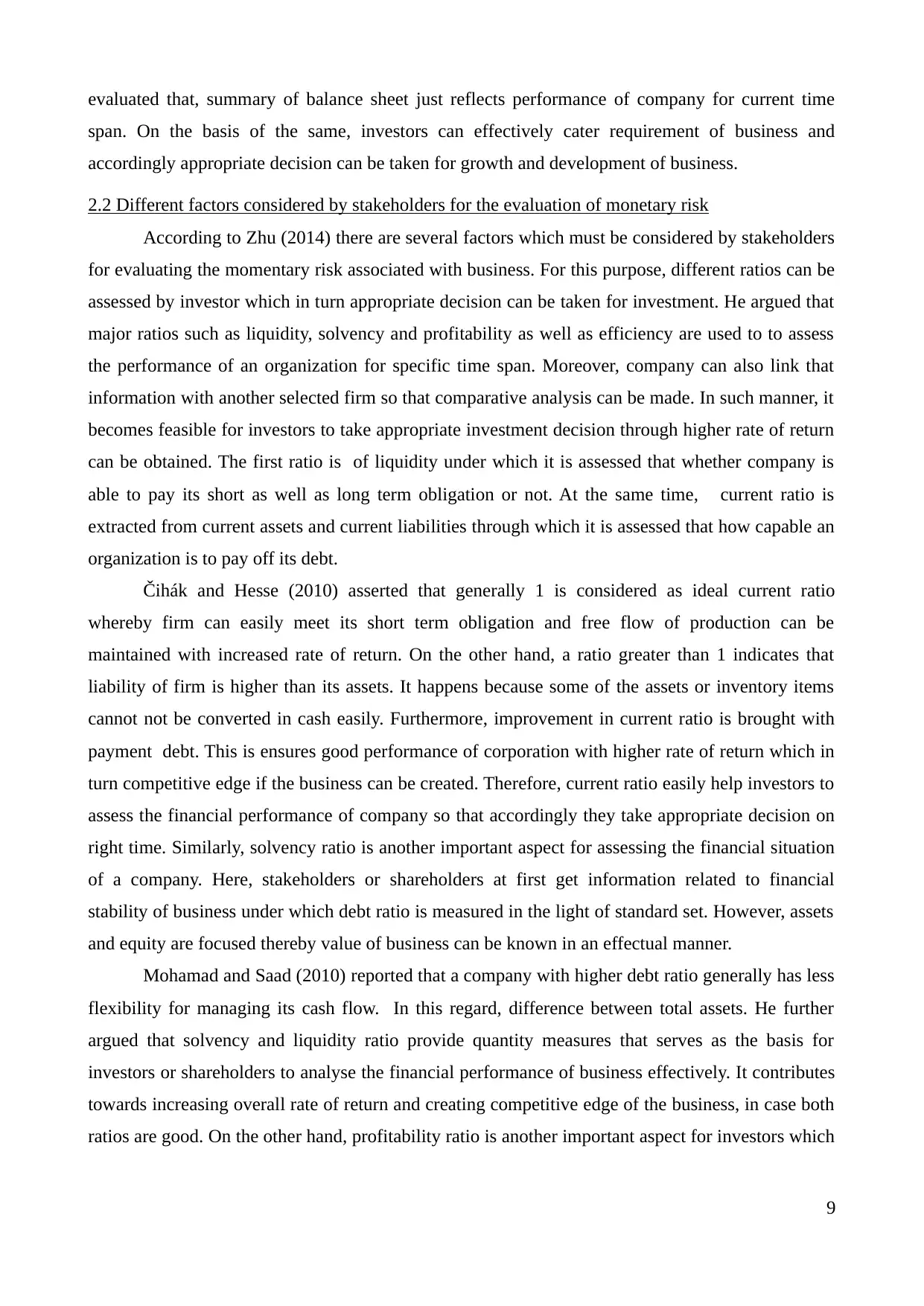
evaluated that, summary of balance sheet just reflects performance of company for current time
span. On the basis of the same, investors can effectively cater requirement of business and
accordingly appropriate decision can be taken for growth and development of business.
2.2 Different factors considered by stakeholders for the evaluation of monetary risk
According to Zhu (2014) there are several factors which must be considered by stakeholders
for evaluating the momentary risk associated with business. For this purpose, different ratios can be
assessed by investor which in turn appropriate decision can be taken for investment. He argued that
major ratios such as liquidity, solvency and profitability as well as efficiency are used to to assess
the performance of an organization for specific time span. Moreover, company can also link that
information with another selected firm so that comparative analysis can be made. In such manner, it
becomes feasible for investors to take appropriate investment decision through higher rate of return
can be obtained. The first ratio is of liquidity under which it is assessed that whether company is
able to pay its short as well as long term obligation or not. At the same time, current ratio is
extracted from current assets and current liabilities through which it is assessed that how capable an
organization is to pay off its debt.
Čihák and Hesse (2010) asserted that generally 1 is considered as ideal current ratio
whereby firm can easily meet its short term obligation and free flow of production can be
maintained with increased rate of return. On the other hand, a ratio greater than 1 indicates that
liability of firm is higher than its assets. It happens because some of the assets or inventory items
cannot not be converted in cash easily. Furthermore, improvement in current ratio is brought with
payment debt. This is ensures good performance of corporation with higher rate of return which in
turn competitive edge if the business can be created. Therefore, current ratio easily help investors to
assess the financial performance of company so that accordingly they take appropriate decision on
right time. Similarly, solvency ratio is another important aspect for assessing the financial situation
of a company. Here, stakeholders or shareholders at first get information related to financial
stability of business under which debt ratio is measured in the light of standard set. However, assets
and equity are focused thereby value of business can be known in an effectual manner.
Mohamad and Saad (2010) reported that a company with higher debt ratio generally has less
flexibility for managing its cash flow. In this regard, difference between total assets. He further
argued that solvency and liquidity ratio provide quantity measures that serves as the basis for
investors or shareholders to analyse the financial performance of business effectively. It contributes
towards increasing overall rate of return and creating competitive edge of the business, in case both
ratios are good. On the other hand, profitability ratio is another important aspect for investors which
9
span. On the basis of the same, investors can effectively cater requirement of business and
accordingly appropriate decision can be taken for growth and development of business.
2.2 Different factors considered by stakeholders for the evaluation of monetary risk
According to Zhu (2014) there are several factors which must be considered by stakeholders
for evaluating the momentary risk associated with business. For this purpose, different ratios can be
assessed by investor which in turn appropriate decision can be taken for investment. He argued that
major ratios such as liquidity, solvency and profitability as well as efficiency are used to to assess
the performance of an organization for specific time span. Moreover, company can also link that
information with another selected firm so that comparative analysis can be made. In such manner, it
becomes feasible for investors to take appropriate investment decision through higher rate of return
can be obtained. The first ratio is of liquidity under which it is assessed that whether company is
able to pay its short as well as long term obligation or not. At the same time, current ratio is
extracted from current assets and current liabilities through which it is assessed that how capable an
organization is to pay off its debt.
Čihák and Hesse (2010) asserted that generally 1 is considered as ideal current ratio
whereby firm can easily meet its short term obligation and free flow of production can be
maintained with increased rate of return. On the other hand, a ratio greater than 1 indicates that
liability of firm is higher than its assets. It happens because some of the assets or inventory items
cannot not be converted in cash easily. Furthermore, improvement in current ratio is brought with
payment debt. This is ensures good performance of corporation with higher rate of return which in
turn competitive edge if the business can be created. Therefore, current ratio easily help investors to
assess the financial performance of company so that accordingly they take appropriate decision on
right time. Similarly, solvency ratio is another important aspect for assessing the financial situation
of a company. Here, stakeholders or shareholders at first get information related to financial
stability of business under which debt ratio is measured in the light of standard set. However, assets
and equity are focused thereby value of business can be known in an effectual manner.
Mohamad and Saad (2010) reported that a company with higher debt ratio generally has less
flexibility for managing its cash flow. In this regard, difference between total assets. He further
argued that solvency and liquidity ratio provide quantity measures that serves as the basis for
investors or shareholders to analyse the financial performance of business effectively. It contributes
towards increasing overall rate of return and creating competitive edge of the business, in case both
ratios are good. On the other hand, profitability ratio is another important aspect for investors which
9
⊘ This is a preview!⊘
Do you want full access?
Subscribe today to unlock all pages.

Trusted by 1+ million students worldwide
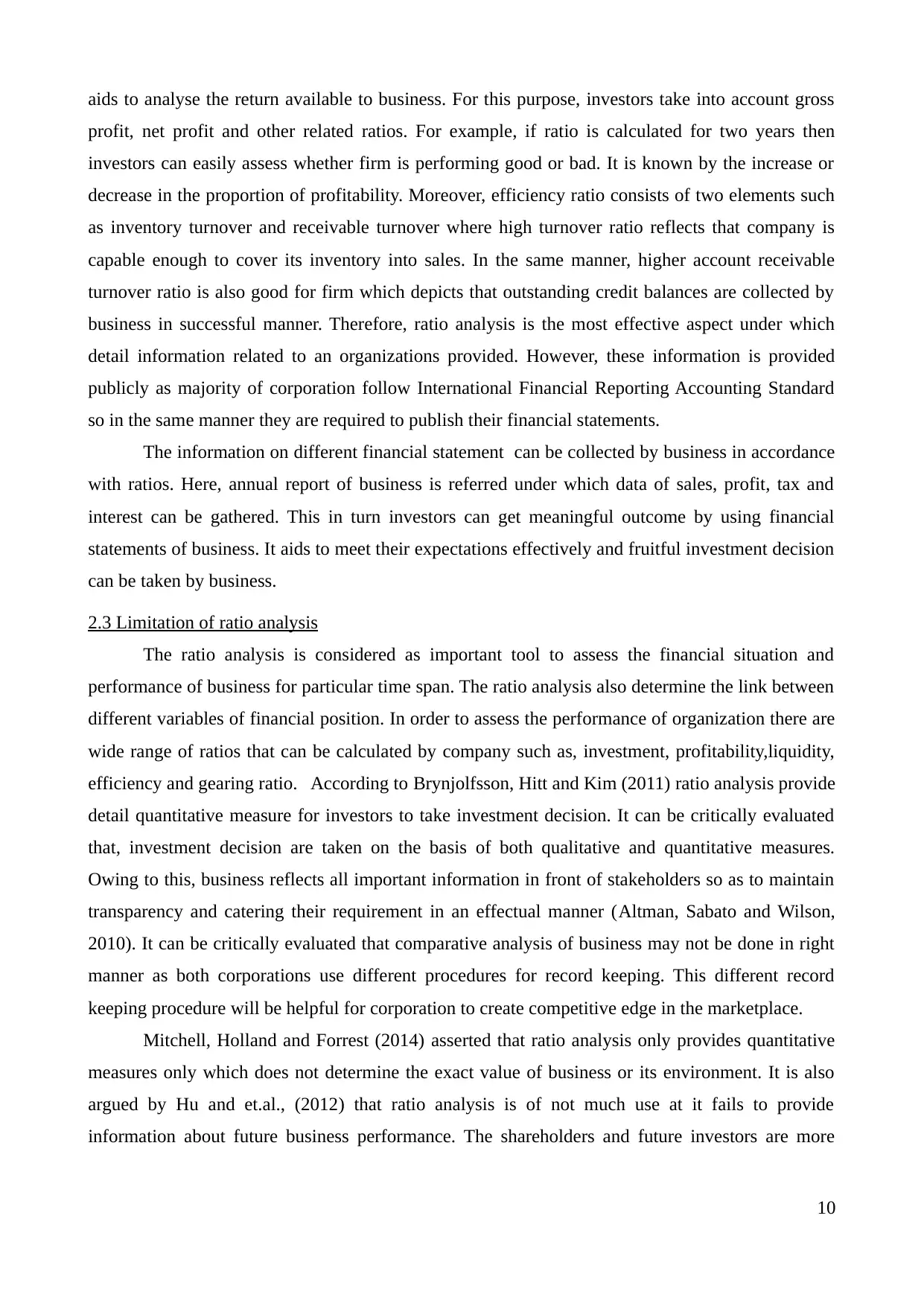
aids to analyse the return available to business. For this purpose, investors take into account gross
profit, net profit and other related ratios. For example, if ratio is calculated for two years then
investors can easily assess whether firm is performing good or bad. It is known by the increase or
decrease in the proportion of profitability. Moreover, efficiency ratio consists of two elements such
as inventory turnover and receivable turnover where high turnover ratio reflects that company is
capable enough to cover its inventory into sales. In the same manner, higher account receivable
turnover ratio is also good for firm which depicts that outstanding credit balances are collected by
business in successful manner. Therefore, ratio analysis is the most effective aspect under which
detail information related to an organizations provided. However, these information is provided
publicly as majority of corporation follow International Financial Reporting Accounting Standard
so in the same manner they are required to publish their financial statements.
The information on different financial statement can be collected by business in accordance
with ratios. Here, annual report of business is referred under which data of sales, profit, tax and
interest can be gathered. This in turn investors can get meaningful outcome by using financial
statements of business. It aids to meet their expectations effectively and fruitful investment decision
can be taken by business.
2.3 Limitation of ratio analysis
The ratio analysis is considered as important tool to assess the financial situation and
performance of business for particular time span. The ratio analysis also determine the link between
different variables of financial position. In order to assess the performance of organization there are
wide range of ratios that can be calculated by company such as, investment, profitability,liquidity,
efficiency and gearing ratio. According to Brynjolfsson, Hitt and Kim (2011) ratio analysis provide
detail quantitative measure for investors to take investment decision. It can be critically evaluated
that, investment decision are taken on the basis of both qualitative and quantitative measures.
Owing to this, business reflects all important information in front of stakeholders so as to maintain
transparency and catering their requirement in an effectual manner (Altman, Sabato and Wilson,
2010). It can be critically evaluated that comparative analysis of business may not be done in right
manner as both corporations use different procedures for record keeping. This different record
keeping procedure will be helpful for corporation to create competitive edge in the marketplace.
Mitchell, Holland and Forrest (2014) asserted that ratio analysis only provides quantitative
measures only which does not determine the exact value of business or its environment. It is also
argued by Hu and et.al., (2012) that ratio analysis is of not much use at it fails to provide
information about future business performance. The shareholders and future investors are more
10
profit, net profit and other related ratios. For example, if ratio is calculated for two years then
investors can easily assess whether firm is performing good or bad. It is known by the increase or
decrease in the proportion of profitability. Moreover, efficiency ratio consists of two elements such
as inventory turnover and receivable turnover where high turnover ratio reflects that company is
capable enough to cover its inventory into sales. In the same manner, higher account receivable
turnover ratio is also good for firm which depicts that outstanding credit balances are collected by
business in successful manner. Therefore, ratio analysis is the most effective aspect under which
detail information related to an organizations provided. However, these information is provided
publicly as majority of corporation follow International Financial Reporting Accounting Standard
so in the same manner they are required to publish their financial statements.
The information on different financial statement can be collected by business in accordance
with ratios. Here, annual report of business is referred under which data of sales, profit, tax and
interest can be gathered. This in turn investors can get meaningful outcome by using financial
statements of business. It aids to meet their expectations effectively and fruitful investment decision
can be taken by business.
2.3 Limitation of ratio analysis
The ratio analysis is considered as important tool to assess the financial situation and
performance of business for particular time span. The ratio analysis also determine the link between
different variables of financial position. In order to assess the performance of organization there are
wide range of ratios that can be calculated by company such as, investment, profitability,liquidity,
efficiency and gearing ratio. According to Brynjolfsson, Hitt and Kim (2011) ratio analysis provide
detail quantitative measure for investors to take investment decision. It can be critically evaluated
that, investment decision are taken on the basis of both qualitative and quantitative measures.
Owing to this, business reflects all important information in front of stakeholders so as to maintain
transparency and catering their requirement in an effectual manner (Altman, Sabato and Wilson,
2010). It can be critically evaluated that comparative analysis of business may not be done in right
manner as both corporations use different procedures for record keeping. This different record
keeping procedure will be helpful for corporation to create competitive edge in the marketplace.
Mitchell, Holland and Forrest (2014) asserted that ratio analysis only provides quantitative
measures only which does not determine the exact value of business or its environment. It is also
argued by Hu and et.al., (2012) that ratio analysis is of not much use at it fails to provide
information about future business performance. The shareholders and future investors are more
10
Paraphrase This Document
Need a fresh take? Get an instant paraphrase of this document with our AI Paraphraser
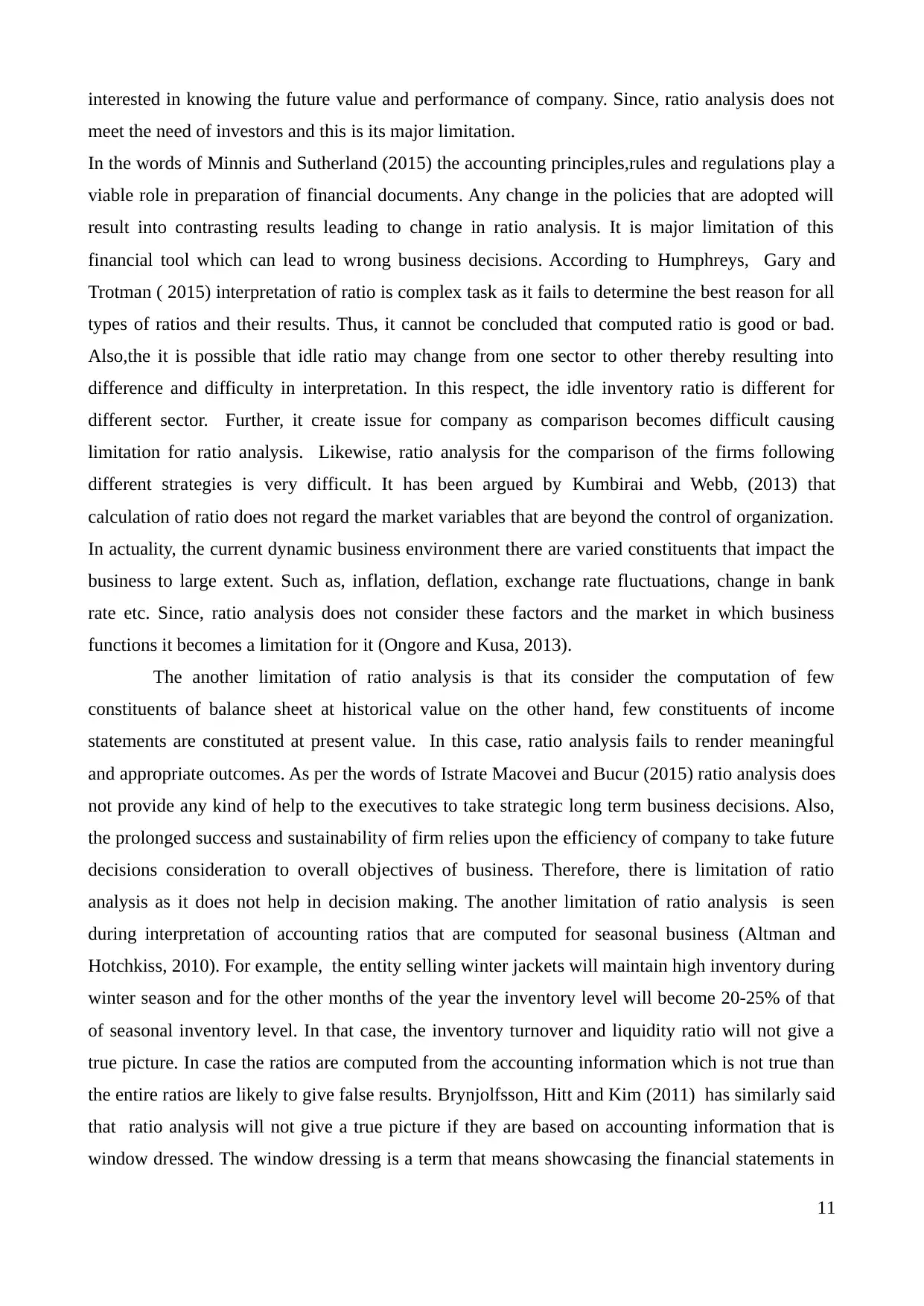
interested in knowing the future value and performance of company. Since, ratio analysis does not
meet the need of investors and this is its major limitation.
In the words of Minnis and Sutherland (2015) the accounting principles,rules and regulations play a
viable role in preparation of financial documents. Any change in the policies that are adopted will
result into contrasting results leading to change in ratio analysis. It is major limitation of this
financial tool which can lead to wrong business decisions. According to Humphreys, Gary and
Trotman ( 2015) interpretation of ratio is complex task as it fails to determine the best reason for all
types of ratios and their results. Thus, it cannot be concluded that computed ratio is good or bad.
Also,the it is possible that idle ratio may change from one sector to other thereby resulting into
difference and difficulty in interpretation. In this respect, the idle inventory ratio is different for
different sector. Further, it create issue for company as comparison becomes difficult causing
limitation for ratio analysis. Likewise, ratio analysis for the comparison of the firms following
different strategies is very difficult. It has been argued by Kumbirai and Webb, (2013) that
calculation of ratio does not regard the market variables that are beyond the control of organization.
In actuality, the current dynamic business environment there are varied constituents that impact the
business to large extent. Such as, inflation, deflation, exchange rate fluctuations, change in bank
rate etc. Since, ratio analysis does not consider these factors and the market in which business
functions it becomes a limitation for it (Ongore and Kusa, 2013).
The another limitation of ratio analysis is that its consider the computation of few
constituents of balance sheet at historical value on the other hand, few constituents of income
statements are constituted at present value. In this case, ratio analysis fails to render meaningful
and appropriate outcomes. As per the words of Istrate Macovei and Bucur (2015) ratio analysis does
not provide any kind of help to the executives to take strategic long term business decisions. Also,
the prolonged success and sustainability of firm relies upon the efficiency of company to take future
decisions consideration to overall objectives of business. Therefore, there is limitation of ratio
analysis as it does not help in decision making. The another limitation of ratio analysis is seen
during interpretation of accounting ratios that are computed for seasonal business (Altman and
Hotchkiss, 2010). For example, the entity selling winter jackets will maintain high inventory during
winter season and for the other months of the year the inventory level will become 20-25% of that
of seasonal inventory level. In that case, the inventory turnover and liquidity ratio will not give a
true picture. In case the ratios are computed from the accounting information which is not true than
the entire ratios are likely to give false results. Brynjolfsson, Hitt and Kim (2011) has similarly said
that ratio analysis will not give a true picture if they are based on accounting information that is
window dressed. The window dressing is a term that means showcasing the financial statements in
11
meet the need of investors and this is its major limitation.
In the words of Minnis and Sutherland (2015) the accounting principles,rules and regulations play a
viable role in preparation of financial documents. Any change in the policies that are adopted will
result into contrasting results leading to change in ratio analysis. It is major limitation of this
financial tool which can lead to wrong business decisions. According to Humphreys, Gary and
Trotman ( 2015) interpretation of ratio is complex task as it fails to determine the best reason for all
types of ratios and their results. Thus, it cannot be concluded that computed ratio is good or bad.
Also,the it is possible that idle ratio may change from one sector to other thereby resulting into
difference and difficulty in interpretation. In this respect, the idle inventory ratio is different for
different sector. Further, it create issue for company as comparison becomes difficult causing
limitation for ratio analysis. Likewise, ratio analysis for the comparison of the firms following
different strategies is very difficult. It has been argued by Kumbirai and Webb, (2013) that
calculation of ratio does not regard the market variables that are beyond the control of organization.
In actuality, the current dynamic business environment there are varied constituents that impact the
business to large extent. Such as, inflation, deflation, exchange rate fluctuations, change in bank
rate etc. Since, ratio analysis does not consider these factors and the market in which business
functions it becomes a limitation for it (Ongore and Kusa, 2013).
The another limitation of ratio analysis is that its consider the computation of few
constituents of balance sheet at historical value on the other hand, few constituents of income
statements are constituted at present value. In this case, ratio analysis fails to render meaningful
and appropriate outcomes. As per the words of Istrate Macovei and Bucur (2015) ratio analysis does
not provide any kind of help to the executives to take strategic long term business decisions. Also,
the prolonged success and sustainability of firm relies upon the efficiency of company to take future
decisions consideration to overall objectives of business. Therefore, there is limitation of ratio
analysis as it does not help in decision making. The another limitation of ratio analysis is seen
during interpretation of accounting ratios that are computed for seasonal business (Altman and
Hotchkiss, 2010). For example, the entity selling winter jackets will maintain high inventory during
winter season and for the other months of the year the inventory level will become 20-25% of that
of seasonal inventory level. In that case, the inventory turnover and liquidity ratio will not give a
true picture. In case the ratios are computed from the accounting information which is not true than
the entire ratios are likely to give false results. Brynjolfsson, Hitt and Kim (2011) has similarly said
that ratio analysis will not give a true picture if they are based on accounting information that is
window dressed. The window dressing is a term that means showcasing the financial statements in
11
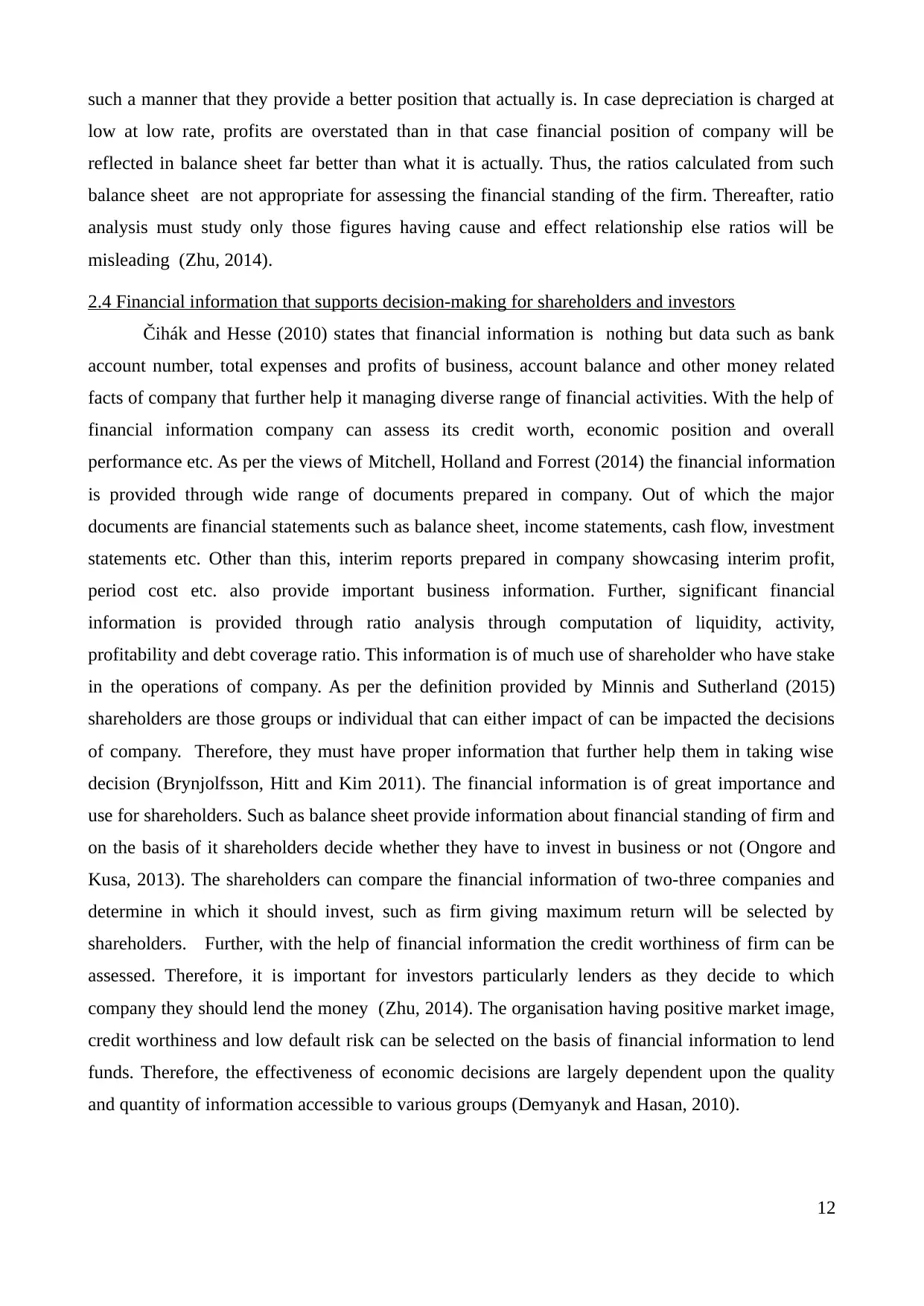
such a manner that they provide a better position that actually is. In case depreciation is charged at
low at low rate, profits are overstated than in that case financial position of company will be
reflected in balance sheet far better than what it is actually. Thus, the ratios calculated from such
balance sheet are not appropriate for assessing the financial standing of the firm. Thereafter, ratio
analysis must study only those figures having cause and effect relationship else ratios will be
misleading (Zhu, 2014).
2.4 Financial information that supports decision-making for shareholders and investors
Čihák and Hesse (2010) states that financial information is nothing but data such as bank
account number, total expenses and profits of business, account balance and other money related
facts of company that further help it managing diverse range of financial activities. With the help of
financial information company can assess its credit worth, economic position and overall
performance etc. As per the views of Mitchell, Holland and Forrest (2014) the financial information
is provided through wide range of documents prepared in company. Out of which the major
documents are financial statements such as balance sheet, income statements, cash flow, investment
statements etc. Other than this, interim reports prepared in company showcasing interim profit,
period cost etc. also provide important business information. Further, significant financial
information is provided through ratio analysis through computation of liquidity, activity,
profitability and debt coverage ratio. This information is of much use of shareholder who have stake
in the operations of company. As per the definition provided by Minnis and Sutherland (2015)
shareholders are those groups or individual that can either impact of can be impacted the decisions
of company. Therefore, they must have proper information that further help them in taking wise
decision (Brynjolfsson, Hitt and Kim 2011). The financial information is of great importance and
use for shareholders. Such as balance sheet provide information about financial standing of firm and
on the basis of it shareholders decide whether they have to invest in business or not (Ongore and
Kusa, 2013). The shareholders can compare the financial information of two-three companies and
determine in which it should invest, such as firm giving maximum return will be selected by
shareholders. Further, with the help of financial information the credit worthiness of firm can be
assessed. Therefore, it is important for investors particularly lenders as they decide to which
company they should lend the money (Zhu, 2014). The organisation having positive market image,
credit worthiness and low default risk can be selected on the basis of financial information to lend
funds. Therefore, the effectiveness of economic decisions are largely dependent upon the quality
and quantity of information accessible to various groups (Demyanyk and Hasan, 2010).
12
low at low rate, profits are overstated than in that case financial position of company will be
reflected in balance sheet far better than what it is actually. Thus, the ratios calculated from such
balance sheet are not appropriate for assessing the financial standing of the firm. Thereafter, ratio
analysis must study only those figures having cause and effect relationship else ratios will be
misleading (Zhu, 2014).
2.4 Financial information that supports decision-making for shareholders and investors
Čihák and Hesse (2010) states that financial information is nothing but data such as bank
account number, total expenses and profits of business, account balance and other money related
facts of company that further help it managing diverse range of financial activities. With the help of
financial information company can assess its credit worth, economic position and overall
performance etc. As per the views of Mitchell, Holland and Forrest (2014) the financial information
is provided through wide range of documents prepared in company. Out of which the major
documents are financial statements such as balance sheet, income statements, cash flow, investment
statements etc. Other than this, interim reports prepared in company showcasing interim profit,
period cost etc. also provide important business information. Further, significant financial
information is provided through ratio analysis through computation of liquidity, activity,
profitability and debt coverage ratio. This information is of much use of shareholder who have stake
in the operations of company. As per the definition provided by Minnis and Sutherland (2015)
shareholders are those groups or individual that can either impact of can be impacted the decisions
of company. Therefore, they must have proper information that further help them in taking wise
decision (Brynjolfsson, Hitt and Kim 2011). The financial information is of great importance and
use for shareholders. Such as balance sheet provide information about financial standing of firm and
on the basis of it shareholders decide whether they have to invest in business or not (Ongore and
Kusa, 2013). The shareholders can compare the financial information of two-three companies and
determine in which it should invest, such as firm giving maximum return will be selected by
shareholders. Further, with the help of financial information the credit worthiness of firm can be
assessed. Therefore, it is important for investors particularly lenders as they decide to which
company they should lend the money (Zhu, 2014). The organisation having positive market image,
credit worthiness and low default risk can be selected on the basis of financial information to lend
funds. Therefore, the effectiveness of economic decisions are largely dependent upon the quality
and quantity of information accessible to various groups (Demyanyk and Hasan, 2010).
12
⊘ This is a preview!⊘
Do you want full access?
Subscribe today to unlock all pages.

Trusted by 1+ million students worldwide
1 out of 33
Related Documents
Your All-in-One AI-Powered Toolkit for Academic Success.
+13062052269
info@desklib.com
Available 24*7 on WhatsApp / Email
![[object Object]](/_next/static/media/star-bottom.7253800d.svg)
Unlock your academic potential
Copyright © 2020–2025 A2Z Services. All Rights Reserved. Developed and managed by ZUCOL.





